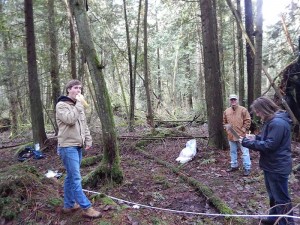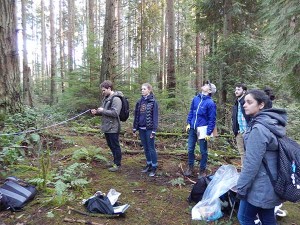This project is a collaboration between Biology 406 and Biology 321 to examine spatial and temporal variation in the forest plant communities of Pacific Spirit Park (PSP). Biology 406 students set up study plots, collected data on forest structure and vascular plant cover, as well as data analysis, while Biology 321 students identified and collected data on bryophytes within the study plots. Students worked in teams of five for this project, two students from Biol 406 and three from Biol 321.
 The overall aim of this project is to evaluate the spatial and temporal patterns in plant communities in different environmental conditions and different successional stages throughout the park. As background information students will have access to forest vegetation data collected in a set of permanent plots established in the early 1980s. In 1985, the results of a baseline survey of the main vegetation associations in PSP, known then as the University Endowment Lands (UEL), were published by Grant Thompson; a portion of Thompson’s report with information on the main environmental conditions, disturbance regimes, and major vegetation associations is available to students. At the time of Thompson’s study a set of 29 permanent plots representing 13 vegetation associations was established that allows ongoing investigation of the kinds of changes that are occurring in the forest vegetation (e.g. succession after disturbance, stand dynamics, spread of exotic species, etc.) In 2007, the 29 permanent plots were resurveyed in a Biology 448 (“directed studies”) project conducted by UBC student Laura Super under the supervision of Drs Mark Vellend and Gary Bradfield (see http://www.davidsonia.org/urbanecology).
The overall aim of this project is to evaluate the spatial and temporal patterns in plant communities in different environmental conditions and different successional stages throughout the park. As background information students will have access to forest vegetation data collected in a set of permanent plots established in the early 1980s. In 1985, the results of a baseline survey of the main vegetation associations in PSP, known then as the University Endowment Lands (UEL), were published by Grant Thompson; a portion of Thompson’s report with information on the main environmental conditions, disturbance regimes, and major vegetation associations is available to students. At the time of Thompson’s study a set of 29 permanent plots representing 13 vegetation associations was established that allows ongoing investigation of the kinds of changes that are occurring in the forest vegetation (e.g. succession after disturbance, stand dynamics, spread of exotic species, etc.) In 2007, the 29 permanent plots were resurveyed in a Biology 448 (“directed studies”) project conducted by UBC student Laura Super under the supervision of Drs Mark Vellend and Gary Bradfield (see http://www.davidsonia.org/urbanecology).
 Each team was required to locate and sample a plot in the general vicinity (within a ~50 m radius) of one of Thompson’s permanent plots. The data obtained from these new plots combined with the earlier data sets allows an assessment of the degree of spatial and temporal dynamics in the different vegetation associations.
Each team was required to locate and sample a plot in the general vicinity (within a ~50 m radius) of one of Thompson’s permanent plots. The data obtained from these new plots combined with the earlier data sets allows an assessment of the degree of spatial and temporal dynamics in the different vegetation associations.
There are three general causes (“factors”) of the vegetation dynamics that students will encounter in the project: temporal – refers to successional changes such as gains and losses of species, as well as changes in species abundance over time in a given area (includes changes arising from species interactions and disturbance); spatial – refers to the spatial heterogeneity in species composition and vegetation structure within an area of uniform environmental conditions (mainly stochastic variation due to slight differences in plot locations); environmental – refers to variation in abiotic conditions (e.g. light, moisture, pH, etc.) that occurs within an area (e.g. increase in light after tree blown-down, or your plot may be in a wetter/drier location than the original permanent plot).
 The Biology 321 students made collections from different substrate types within each plot. Their data will contribute to the overall vegetation study as well as examine substrate specificity.
The Biology 321 students made collections from different substrate types within each plot. Their data will contribute to the overall vegetation study as well as examine substrate specificity.
